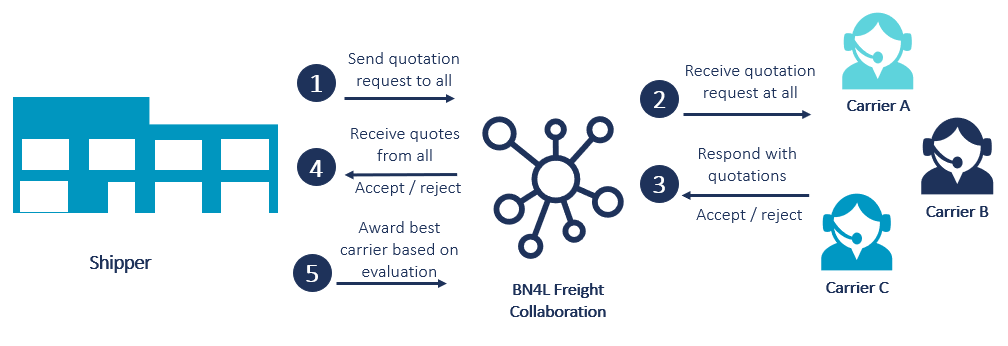Complex tendering and contracting processes lead to inefficiencies, delivery delays, and higher transportation costs. SAP Business Network for Logistics – Freight Collaboration offers features for more efficient tendering, subcontracting, and external planning.
For shippers and logistics service providers (LSPs), the reliance on external carriers to execute transportation activities is paramount. Ensuring timely access to the right capacities is critical for seamless planning and execution. During peak seasons, the availability of transport resources becomes even more crucial due to heightened demand from numerous shippers and LSPs.
However, managing capacity bookings and navigating contracting processes with multiple carriers prove to be daunting challenges, leading to operational inefficiencies, delivery delays, customer dissatisfaction, and increased transportation costs. Despite the digitalization of freight collaboration, the lack of a unified solution for effective communication with freight partners remains a persistent issue. Addressing these challenges is vital for optimizing operations and customer satisfaction.
By embracing an integrated platform such as SAP Business Network for Logistics – Freight Collaboration (SAP BN4L – FC), shippers and LSPs can streamline capacity management, simplify contracting, and enhance communication with carriers. This comprehensive solution empowers businesses to overcome inefficiencies, reduce costs, and improve overall performance, thereby reinforcing their competitive position in the market.
SAP BN4L – FC efficiently tackles these challenges by facilitating collaboration between shippers and freight partners through streamlined processes. We elaborated on collaboration and material traceability in our previous article about the benefits of freight collaboration with SAP BN4L – FC.
With BN4L – FC, shippers can seamlessly connect with multiple freight partners, creating a unified network through seamless integration. This eliminates the need for individual point-to-point connections, simplifying freight contracting processes such as tendering and subcontracting. By adopting SAP BN4L – FC, businesses can optimize their logistics operations, enhance collaboration, and drive efficiency throughout the supply chain. We will share details on tendering, subcontracting, and external planning in this article.

Tendering
In road transportation, the tendering process serves as a strategic method for selecting the most optimal carrier to fulfill transportation services. Two primary approaches are commonly employed in tendering transport orders: broadcast tendering and peer-to-peer tendering.
Broadcast Tendering
To initiate this approach, the shipper identifies the carrier or a curated list of carriers for the specific transport order. A Request for Quotation (RFQ) is then promptly disseminated to all designated carriers simultaneously. The carriers respond by providing their respective freight quotations. Depending on the shipper’s specific requirements, two scenarios may unfold:
- Expedited award: In certain cases, the shipper may choose to award the contract directly to the carrier who responds first. This swift decision-making process allows for immediate execution, ensuring time-sensitive operations proceed without delay.
- Comprehensive evaluation: Alternatively, the shipper may exercise patience and allocate a predetermined timeframe for all carriers to submit their responses. By waiting until the specified deadline, the shipper can gather a comprehensive range of offers from the carriers. This allows for a meticulous evaluation of the terms and conditions proposed, enabling the shipper to select the most favorable offer that aligns with their requirements and maximizes business objectives.

Peer-to-Peer Tendering
In this method of tendering, the shipper initiates the process by sending a request to the first carrier on the list. If the carrier accepts the request and provides a quote that meets the specified requirements, they are awarded the contract. If the carrier rejects the RFQ, the shipper proceeds to the next carrier on the list and repeats the process until a carrier accepts the request. Once a carrier accepts, there is no additional step of awarding required in the “direct” tendering process.
By leveraging these tendering processes, shippers can effectively optimize their transportation planning operations and secure cost-effective capacities. This can be achieved through the utilization of advanced tools such as SAP BN4L – Freight Collaboration, which acts as a middleware or collaboration portal, facilitating seamless communication and streamlining the booking of capacities with carrier partners.
Implementing these strategic tendering practices empowers businesses to enhance their logistics operations, cultivate valuable partnerships with reliable carriers, and ultimately gain a competitive edge in the marketplace.
Subcontracting
For maritime and air transport, the operational landscape differs from road transportation, as shipping lines or airlines as carriers typically adhere to fixed schedules. As a result, tendering processes are not commonly employed in these scenarios. Instead, shippers and LSPs primarily utilize a method known as “subcontracting” to engage forwarders or carriers directly for planned transports.
The process begins with the selection of a primary forwarder or carrier, based on transportation lanes or predetermined schedules. This careful selection ensures compatibility and efficiency in executing transport activities. Once the primary forwarder or carrier is identified, the shipper or LSP proceeds with communicating the capacity requirements and exact dates to the selected party.
With information on transport capacity and timing, the carrier has the opportunity to evaluate their capabilities and determine whether they can fulfill the required transport capacity. Based on this assessment, the carrier may either accept the request, indicating their readiness to proceed with the transport activities, or reject it if they are unable to meet the specified capacity requirement.
This direct engagement between the shipper/LSP and the carrier streamlines the communication process, ensuring a swift and efficient exchange of information. By leveraging subcontracting in maritime and air transports, businesses can effectively secure the necessary transport capacity and establish reliable partnerships with forwarders or carriers that align with their specific requirements.
Through this strategic approach, shippers and LSPs can optimize their logistical operations, capitalize on established carrier schedules, and maintain a competitive edge in the marketplace.

External Planning with 4PL providers
In certain instances, shippers opt for the expertise of Fourth Party Logistics providers (4PLs) to handle their transportation planning requirements, effectively reducing the overhead and intricacies associated with internal planning and optimization activities. By entrusting their transport needs to external service providers, shippers can streamline their logistics operations and focus on core business functions.
Under this methodology, shippers furnish a comprehensive list of transportation requirements to the 4PL. In response, the 4PL utilizes their industry knowledge and resources to devise a well-structured transportation plan that meets the shipper’s specifications. The 4PL then provides the shipper with confirmation of the planned transportation orders, ensuring clarity and transparency throughout the process.
By outsourcing transportation planning and optimization activities to external service providers, shippers benefit from several advantages. Firstly, they can tap into the specialized expertise of 4PLs, who possess in-depth knowledge of the logistics landscape and can leverage their network and experience to design efficient transport solutions. This allows shippers to enhance operational efficiency while mitigating the complexities associated with logistics activities.
To facilitate seamless collaboration between shippers and 4PLs, cutting-edge technological solutions such as SAP BN4L – Freight Collaboration come into play. With this advanced platform, shippers can seamlessly transmit their transportation requirements from their backend systems to the service providers. The 4PL, in turn, utilizes the capabilities of the platform to generate and send out transportation orders back to the shippers, ensuring a streamlined and efficient exchange of information.
By embracing this business approach, shippers can harness the benefits of outsourced transportation planning, optimize their logistics activities, and leverage the expertise of external service providers. Ultimately, this enables shippers to allocate resources more effectively, reduce costs, and achieve greater supply chain agility in today’s competitive business landscape.

Seamless Collaboration for Tendering Processes
SAP BN4L – Freight Collaboration is a comprehensive solution that caters to the needs of both shippers and carriers in the logistics industry. It comprises two key components: the shipper tenant and the carrier tenant, which serve as collaborative networks seamlessly integrated with respective backend systems.
The shipper tenant is designed to connect with the shipper’s backend system, such as SAP TM (Transportation Management), enabling a seamless flow of data and information. By establishing this connection, shippers gain the ability to leverage the robust capabilities of SAP BN4L within their existing infrastructure. This integration empowers shippers to optimize their transportation planning, execution, and monitoring processes, streamlining their operations for enhanced efficiency and productivity.
Conversely, the carrier tenant provides carriers with a dedicated collaboration network that seamlessly integrates with their transport system. By connecting their transport system to the carrier tenant, carriers can leverage the advanced features and functionalities of SAP BN4L to streamline their operations and improve their overall service delivery.
The integration facilitates efficient communication, real-time data exchange, and collaborative decision-making between carriers and other stakeholders in the logistics ecosystem.
Through the cohesive interaction between the shipper and carrier tenants within SAP BN4L, businesses can establish a robust collaboration network that spans the entire transportation value chain. This allows for seamless coordination, optimized resource allocation, and effective decision-making to drive operational excellence and maximize customer satisfaction.
By adopting SAP BN4L – Freight Collaboration, shippers and carriers can leverage the power of advanced technology, integration, and collaboration to achieve greater visibility, control, and efficiency in their logistics operations. This comprehensive solution empowers businesses to navigate the complexities of the logistics landscape, enhance their competitive advantage, and unlock new opportunities for growth and success.
Camelot offers comprehensive services to implement SAP BN4L capabilities and benefit from collaborative processes. Visit the service’s website to learn more about our offering.

